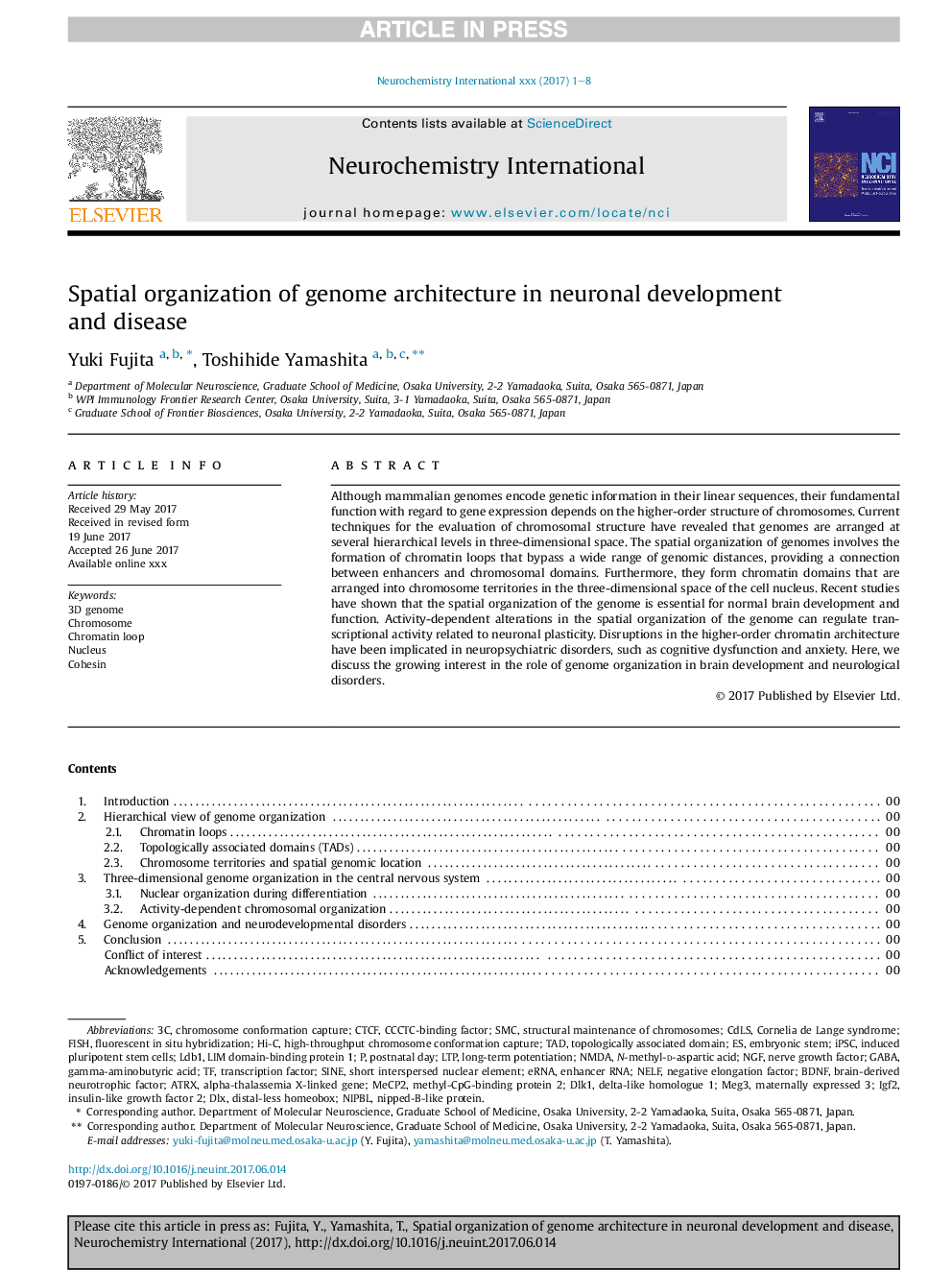| کد مقاله | کد نشریه | سال انتشار | مقاله انگلیسی | نسخه تمام متن |
|---|---|---|---|---|
| 8956347 | 1646148 | 2018 | 8 صفحه PDF | دانلود رایگان |
عنوان انگلیسی مقاله ISI
Spatial organization of genome architecture in neuronal development and disease
ترجمه فارسی عنوان
سازمان فضایی معماری ژنوم در توسعه و بیماری های عصبی
دانلود مقاله + سفارش ترجمه
دانلود مقاله ISI انگلیسی
رایگان برای ایرانیان
کلمات کلیدی
MEG33D genomeLdb1CdLSNIPBLDlk1cohesinCTCFDLXIGF2ATRXN-methyl-d-aspartic acidNELFMecp2IPSCNMDANGFSMCBDNF - BDNF یا فاکتور نورونزایی مشتقشده از مغز enhancer RNA - RNA تقویت کنندهSINE - آنهاeRNA - ارناgamma-aminobutyric acid - اسید گاما آمینو بوتیریکTAD - بلهlong-term potentiation - تقویت درازمدتLTP - تقویت طولانی مدت یا LTP chromatin loop - حلقه کروماتینtopologically associated domain - دامنه مرتبط با توپولوژیpostnatal day - روز پس از زایمانembryonic stem - ساقه جنینHi-C - سلام CInduced pluripotent stem cells - سلول های بنیادی پرتوان القاییCornelia de Lange Syndrome - سندرم کرنلیا د لانگهchromosome conformation capture - ضبط کروموزوم سازگاریnegative elongation factor - ضریب انقباض منفیCCCTC-binding factor - عامل اتصال دهنده CCCTCTranscription factor - عامل رونویسیshort interspersed nuclear element - عنصر هسته ای مشتق شده کوتاهnerve growth factor - فاکتور رشد عصبinsulin-like growth factor 2 - فاکتور رشد مانند انسولین 2Brain-derived neurotrophic factor - فاکتور نوروتروفی مشتق شده از مغزfluorescent in situ hybridization - فلورسنت در محل hybridizationFish - ماهیstructural maintenance of chromosomes - نگهداری ساختاری کروموزوم هاNucleus - هستهmethyl-CpG-binding protein 2 - پروتئین متصل CpG متیل 2Chromosome - کروموزمGABA - گابا
ترجمه چکیده
گرچه ژنومهای پستانداران در توالی خطی خود اطلاعات ژنتیکی را رمزگذاری می کنند، عملکرد اساسی آنها با توجه به بیان ژن بستگی به ساختار مرتبه بالاتر از کروموزوم ها دارد. تکنیک های کنونی برای ارزیابی ساختار کروموزومی نشان داده اند که ژنوم ها در سطوح مختلف سلسله مراتبی در فضای سه بعدی مرتب شده اند. سازمان فضایی ژنوم ها شامل تشکیل حلقه های کروماتین می شود که از طیف وسیعی از فاصله های ژنوم عبور می کند و ارتباط بین افزایش دهنده ها و حوزه های کروموزومی را فراهم می کند. علاوه بر این، آنها دامنه های کروماتین را تشکیل می دهند که در فضاهای سه بعدی هسته سلولی در سرتاسر کروموزوم قرار دارند. مطالعات اخیر نشان داده است که سازمان فضایی ژنوم برای رشد و عملکرد طبیعی مغز ضروری است. تغییرات وابسته به فعالیت در سازمان فضایی ژنوم می تواند فعالیت رونویسی مربوط به پلاستیک عصبی را تنظیم کند. اختلال در ساختار کروماتین بالاتر مرتبه در اختلالات روانپزشکی مانند اختلال شناختی و اضطراب دخالت دارد. در اینجا، ما در مورد علاقه در حال رشد در نقش سازمان ژنوم در توسعه مغز و اختلالات عصبی بحث می کنیم.
موضوعات مرتبط
علوم زیستی و بیوفناوری
بیوشیمی، ژنتیک و زیست شناسی مولکولی
بیولوژی سلول
چکیده انگلیسی
Although mammalian genomes encode genetic information in their linear sequences, their fundamental function with regard to gene expression depends on the higher-order structure of chromosomes. Current techniques for the evaluation of chromosomal structure have revealed that genomes are arranged at several hierarchical levels in three-dimensional space. The spatial organization of genomes involves the formation of chromatin loops that bypass a wide range of genomic distances, providing a connection between enhancers and chromosomal domains. Furthermore, they form chromatin domains that are arranged into chromosome territories in the three-dimensional space of the cell nucleus. Recent studies have shown that the spatial organization of the genome is essential for normal brain development and function. Activity-dependent alterations in the spatial organization of the genome can regulate transcriptional activity related to neuronal plasticity. Disruptions in the higher-order chromatin architecture have been implicated in neuropsychiatric disorders, such as cognitive dysfunction and anxiety. Here, we discuss the growing interest in the role of genome organization in brain development and neurological disorders.
ناشر
Database: Elsevier - ScienceDirect (ساینس دایرکت)
Journal: Neurochemistry International - Volume 119, October 2018, Pages 49-56
Journal: Neurochemistry International - Volume 119, October 2018, Pages 49-56
نویسندگان
Yuki Fujita, Toshihide Yamashita,
